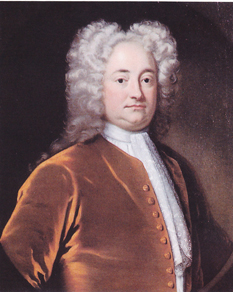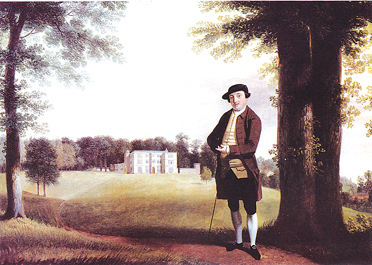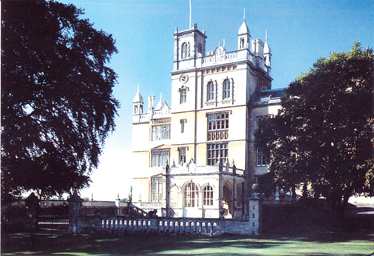|
English has absorbed many Indian words. How many of us would guess that ‘snob’ is one of them? ‘Snob’, or ‘nob’, is a shortened version of ‘Nabob’, which itself was anglicised from the Arabic word ‘Na’ib’, meaning deputy. A Nabob was an employee of the East India Company who lived in India, made his fortune (legally or/and illegally) and returned to England (usually the county of Berkshire, not far from London) to spend it. You get a fascinating glimpse into the lives of the Nabobs and their methods of making money, a part of our history we don’t often read about, in the book Nabobs of Berkshire (2010), privately published by Clive Williams in the UK, which traces the history and lives of these Nabobs who lived in India and returned home the richer.

Governor Richard Benyon
|
But, for every Nabob who made several million pounds, there were many who died a premature death. In Calcutta, or in the islands of Indonesia, it was not uncommon to attend the funeral of a man you just had breakfast with in the morning! Among all the East India possessions, Madras seems to have had the most congenial climate, thanks to its location on the coast. Both Bombay and Calcutta had malarial swamps or warring Maratha kings to contend with. Perhaps this is why so many of our current institutions of modern India owe their genesis to Madras.
The book can be divided into three parts. Part One is an excellently written history of the East India Company, Part Two looks at the life of the Nabobs and how they made their money, and Part Three is a detailed history of all the Nabobs and the country houses they built for themselves in Berkshire.
The Honourable East India Company was established in December 1600 during the reign of Elizabeth I. It received its final death blow in 1858 when, by royal proclamation, Victoria became the Empress of India. During those 250 years and more, the Company had a remarkable knack for, in some ways, sticking to its core purpose of trade while also going beyond that into politics. It also had an ability to weather (with varying levels of success) several local rulers, competition from other countries, and employees with varying levels of probity and efficiency! Behind all of this was solid economics and price arbitration. Ten pounds of nutmeg that cost a penny in Indonesia sold for £2-10 in London, a mark-up of a mindboggling 60,000 per cent. Cloves and pepper were also similar temptations. This meant all the households who could afford spices and tea actually kept them locked away in safes that could still be seen in many of the homes of those days in the UK. The Company had little success in the East Indies and gave in to the Dutch, but was successful in India, where it differed from the Portuguese who had strong missionary aims and the Dutch who were not always popular traders for their excessive use of firearms. The Company’s first success was in the Mughal port of Surat but, after 1630-31, Masulipatam became more attractive and thereafter commenced the hunt for land on the Coromandel Coast. Madras was founded – and had the advantage of being the closest port to the Company’s trading posts in the Far East and China. After the English Civil War, the Company was allowed by Charles II to fortify settlements and two-year terms were created for the Governors, Deputy Governors and Directors, some of whom had strong connections with Madras.
After Governor Pitt, it was Robert Clive’s policies that had the Company getting involved in politics.
Joining the Company was expensive – only a dozen or so were recruited and even to enter the competition, an applicant had to spend as much as £ 50,000 in today’s money! After that, if he survived the health risks, there was enough opportunity to make a fortune by legitimate, dubious, and illegitimate (or combinations thereof) means but there were expenses as well. Nabobs had large retinues of servants. Even minor Nabobs had as many as 60 employees; some of them received commissions from the Nabob on his business transactions.
Entertainment consisted of gambling (the Company on several occasions deplored the high stakes even women had played for), hunting, racing, gaming and animal fights. While in the early period the English were allowed to marry Indians, as time progressed many English women travelled to India to find spouses.
Greedy Nabobs like Clive could make several millions without breaching Indian law and honest Nabobs who did personal trade but, like Warren Hastings, could make as much as minimum £ 8 million by today’s standards in 1786. Positions that offered possibilities of fortunes were those of the Sheriff, Lawyers, Clergymen, Ship’s captains and Military officers. Trade was, however, the most common way. Contracts were another way, with even as much as £ 6 million in today’s money being made from a single important contract. As difficult to make a fortune as was to ship it back, smart Nabobs did it over a long period when they were in India, taking advantage of bills, exchange rates and security. Some also chose the riskier option of trusting their successor to send back instalments when they themselves returned home.
Back in England, the Nabobs, the nouveau riche that they were, wanted to be as close to London and Royalty (in Windsor) as possible. Of the 31 Nabobs who came back to live in Berkshire, some had strong Madras connections. Clive Williams talks of a few of them in his book that has me wanting to go and visit these homes.
Chiltern or Chiltern Lodge near Hungerford is a house built on the site of an older house that was owned by two Nabobs, one of whom, General Richard Smith (1734-1803), had strong connections with Madras. We know little of his origins except that he was the son of a cheese-monger and this was something he hated being mentioned. He arrived in Madras in 1752. Although in the Army, he was not involved in the Battle of Plassey, but he led his troops across the flooded Coleroon in Tanjore.
He married a wealthy Captain’s daughter and made much of his fortune from the military and trade in Madras at the time. Lending money to the Nawab of Arcot was also lucrative for Madras merchants, since his credit was so low and his need for money great. He paid 25 per cent interest to attract new funds and Smith invested £ 6 million in today’s money with the Nawab in 1764. He represented the creditors of the Nawab, who were terrified that their loans would not be repaid. He was in England for a short period and returned to India but seems to have been mostly in Bengal. He returned to England in 1770, aged 36, with a fortune of £ 20-30 billion in today’s money. Much of this was gambled away.
Swallowfield Park was owned by Thomas Pitt and by several Nabobs after him. He was one of the earliest Nabobs and started life as an interloper who breached the Company’s monopoly but eventually became a staunch Company man. Pitt became a Company employee during his second India visit in 1695. He was Governor of Madras and it was in 1702 that he purchased the diamond named after him and now in the Louvre. He brought this from Jamchund for £ 2.4 million in today’s money. Pitt was also a great diplomat and narrowly avoided a war in Madras with the Nawab of Arcot by giving him gifts of oranges! Pitt also on occasion had to resolve the caste disputes between the Right Hand and the Left Hand castes. The Right Hand castes decided to leave Madras and Pitt was dissuaded from sending the army to bring them back (to ensure life functioned normally since the castes were divided also on occupations) and agreed to allow the Armenians, Persians and Muslims to mediate successfully. Pitt’s most famous act for Madras was his survey of the town and, fortunately, the map still survives. For the Company, he shipped home new neck clothes and chintzes. On his return, he purchased Swallowfield where he lived for the last eight years of his life.
Shottesbrooke Park, Bisham Abbey and Foxley Manor are all associated in various ways with the Vansittarts. They were the largest of all the Nabob families. More than twenty were Nabobs or married into powerful Nabob families. Peter Vansittart (1651-1705) founded the English branch of the family. Henry married the daughter of Nicholas Moore, Governor of Madras (1744-6). Another descendant, Amelia (1758-1788), married Edward Parry. Another Henry was a close confidant of Clive in the military action against Fort David, Cuddalore. Most other members of the family were distinguished Company employees in West Bengal.

Englefield House in the 18th Century

Englefield House today |
Warfield Park no longer stands. It was for a while occupied by Col. John Walsh (1726-95). Much of his life was spent in Bengal, but he was born in Madras in 1726.
Englefield House was the home of Richard Benyon and although it is not owned by the family now, his descendants continue to own several of his personal possessions. Father, son and grandson were all called Richard Benyon and they all had connections with Madras.
Richard the first was appointed Governor in 1735. He returned with a fortune of £ 7.5 million in today’s terms – and he was considered an honest Governor. Raw silk and diamonds were the objects of private trade he indulged in. He just avoided the French siege of Madras, but in his time had to contend with the armies of Hyderabad, Golconda etc. He is said to have developed good relationships in Madras, especially with Coja Petrus Uscan, a leading Armenian merchant, who built the first bridge across the Adyar River. Benyon also hosted the Nawab of Arcot’s family in 1741 and an account gives us a glimpse into some of the jewellery the Nawab and the family wore! Benyon’s trading partner, a Cashia (Kasi?) Chittee(Chetti?) Andepra, made his own fortune of more than £ 2 million in today’s money!
I hope that the author of the book will in a subsequent volume look at the country homes of Nabobs across the UK, beyond Berkshire. Those like Sezincote, unlike the ones covered in the book, were not only built by Nabobs but were also designed to look like Indian palaces with many ornaments in the house and gardens copied/inspired by Indian themes.
|